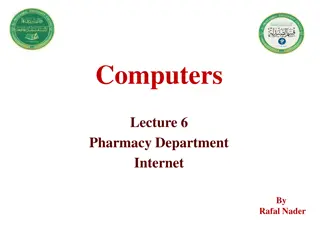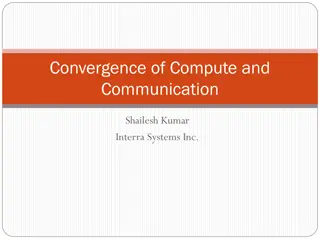Understanding Edge Computing for Optimizing Internet Devices
Edge computing brings computing closer to the data source, minimizing communication distances between client and server for reduced latency and bandwidth usage. Distributed in device nodes, edge computing optimizes processing in smart devices instead of centralized cloud environments, enhancing data analysis, AI, and resource allocation. It involves a network of micro data centers for local data storage and processing, reducing traffic to centralized repositories. IoT devices play a crucial role in transferring and processing data locally before sending a portion to centralized processing hubs. This decentralization of processing power at the edge of the network ensures real-time data processing with minimal latency and decreased network load.
Download Presentation

Please find below an Image/Link to download the presentation.
The content on the website is provided AS IS for your information and personal use only. It may not be sold, licensed, or shared on other websites without obtaining consent from the author. Download presentation by click this link. If you encounter any issues during the download, it is possible that the publisher has removed the file from their server.
E N D
Presentation Transcript
Rajendra Gupta Scientist F NIC UP State Centre Lucknow 1
Edge computing optimizes internet devices (Desktop Computers, Mobile phones, Tablets, Smart TVs, Game Consoles, Wristwatches, Ebook readers, Digital Camera etc)and web applications by bringing computing closer to the source of the data. This minimizes the need for long distance communications between client and server, which reduces latency and bandwidth usage. 2
Edge Computing is a distributed computing paradigm computation classified device nodes known as smart devices or edge devices as opposed to processed in a centralized cloud environment or data centers. It helps to provide server resources, data analysis, and artificial intelligence to data collection sources and cyber-physical sources like smart sensors and actuators. in which performed processing and on are mainly 4
A network of micro data centers that store or process critical data locally and push received data to a centralized data center or repository of cloud storage. Typically in IoT use cases, a massive chunk of data goes through the data center, but edge computing processes the data locally results in reduced traffic in the central repository. 5
This is done by IoT devices, transferring the data to the local device, which includes storage, compute, and network connectivity. After that, data is processed at the edge while another portion is sent to storage repository or central processing in the data center. 6
Computing at the edge of network It focuses bringing computing as close to the source of data It decentralizes processing power to ensure real-time processing without latency while reducing requirements on the network It processes data locally at local network infrastructure instead sending all the data to the cloud data centre bandwidth and storage 8
Concept of Edge started dates back to 1990 when challenge of web traffic congestion was solved by introducing Content Delivery Network (CDN) solutions. The technology involved network nodes storing static cached media information at locations closer to end- users. Edge computing takes this concept further, introducing computational capabilities into nodes at the network edge to process information and deliver services. 9
Edge It highly depends on the use cases. Like in telecommunication, it may be a cell phone or cell tower. Similarly, in the automotive example, it could be a car. In manufacturing, it could be a machine, and In the Information Technology field, it could be a laptop. Edge Devices A device which produces data is edge devices like machines and sensors, or any devices through which information is collected and delivered. Edge Edge Devices 10
It is the place where the device or the local network communicating with internet. E.g. a user s computer or the processor inside of an IoT camera can be considered the network edge, but the user s router, ISP, or local edge server are also considered the edge. The important takeaway is that the edge of the network is geographically unlike cloud servers, which can be very far from the devices they communicate with. containing the device close to the device, 11
In IoT, with the help of edge computing, intelligence moves to the edge. There are various scenarios where speed and high-speed data are the main components for management, power issues, analytics, and real-time need, etc. helps to process data with edge computing in IoT. 12
Edge Computing and Fog Computing are the extensions of Cloud Networks, which are a collection of servers comprising a distributed network. Such networks allow organizations to exceed the resources that would be otherwise available to them. The main advantage of cloud networks is that they allowed data to be collected from multiple sources, which is accessible anywhere over the internet. 15
While Fog Computing and Edge Computing are almost similar, where the talk about intelligence and processing of data at the time of creation. Fog Computing focus more on intelligence at local area network and this architecture transmits data from endpoints to a gateway where it is sent to sources for processing and return to transmission while Edge Computing focus more on computing power and processing of data locally at the edge of a network. It performs processing on embedded computing platforms interfacing to sensors and controllers. 16
Cloud Layer Big Data Processing Data Warehousing Business Logic Cloud Layer Fog Layer Local Network Data Analysis and Reduction Standardization Fog Layer Edge Layer Large Volume Real-Time Data Processing On premises Data Visualization Embedded Systems Gateways Micro Data Storage Edge Layer 18
When IoT devices have poor connectivity. Not efficient for IoT devices to be in constant touch with the central cloud. The latency factor reduces latency because data doesn t have to traverse over a network to a central cloud for processing. Where latencies are untenable like manufacturing or financial services. As soon as data is produced, it doesn t need to send over a network; instead, it compiles the data and sends daily reports to the cloud for long term storage, i.e., reduces the data traversing. The buildout of the next-generation 5G cellular networks by telecommunication companies. Direct access to gateway into the telecom provider s network, which connects to a public IaaS cloud provider. 19
Consider a building secured with dozens of high- definition IoT video cameras. These are dumb cameras that simply output a raw video signal and continuously stream that signal to a cloud server. On the cloud server, the video output from all the cameras application to ensure that only clips featuring activity are saved to the server s database. This means there is a constant and significant strain on the building s Internet infrastructure, as significant bandwidth gets consumed by the high volume of video footage being transferred. Additionally, there is very heavy load on the cloud server that has to process the video footage from all the cameras simultaneously. is put through a motion-detection 20
Now imagine that the motion sensor computation is moved to the network edge. What if each camera used its own internal computer to run the motion-detecting application and then sent footage to the cloud server as needed? This would result in a significant reduction in bandwidth use, because much of the camera footage will never have to travel to the cloud server. Additionally, the cloud server would now only be responsible for storing the important footage, communicate with a higher number of cameras without getting overloaded. This is what edge computing looks like. meaning that the server could 21
Environmental factors like road traffic density, air quality, weather, school holidays, and other open data sets give better results by the processing of data with the help of edge computing and machine learning. The computing power will apply these factors to the data collected from healthcare at the point of admission, where data to be set where the patient expected to be discharged. There is also a movement from businesses in all sectors to use edge computing. 22
Smart applications and devices respond to data, instantly eliminating lag time. Real-time data process with any latency where even milliseconds in latency make a difference in the processing of data. Acceleration in the data stream. Efficient data processing in massive data. Effective use of the application in a remote location. Security for sensitive data even without putting in the public cloud. 23
As we know, edge allows us to manage your connectivity and disperse processing closer to where data is, the advantage is a natural evolution when you optimize some part of your stack in the network with giving more localized services for your application. Moving the analysis of clinical information to edge computing is crucial for healthcare organizations that want to benefit from going digital and the key to digital healthcare problems. For example, in the hospital, we collect data from IoT devices, which is monitoring patients and transfer it to the trust s electronic health record (EHR) from the bedside, with the authentication of staff to the IoT devices through proximity cards. 24
As seen in the example above, edge computing helps minimize bandwidth use and server resources. Bandwidth and cloud resources are finite and cost money. With every household and office becoming equipped with smart cameras, printers, thermostats etc. and as per Statistical predicts that by 2025 there will be over 75 billion IoT devices installed worldwide. In order to support all those devices, significant amounts of computation will have to be moved to the edge. 25
Another significant benefit of moving processes to the edge is to reduce latency. Every time a device needs to communicate with a distant server somewhere, that creates a delay. For example, two co-workers in the same office chatting over an Internet Messaging platform might experience a sizable delay because each message has to be routed out of the building, communicate with a server somewhere across the globe, and be brought back before it appears on the recipient s screen. If that process is brought to the edge, and the company s internal router is in charge of transferring intra-office chats, that noticeable delay would not exist. 26
Similarly, when users of all kinds of web applications run into processes that have to communicate with an external server, they will encounter delays. The duration of these delays will vary based upon their available bandwidth and the location of the server, but these delays can be avoided altogether by bringing more processes to the network edge. 27
In addition, edge computing can provide new functionality that wasn t previously available. For example, a company can use edge computing to process and analyze their data at the edge, which makes it possible to do so in real time. 28
Decreased latency Decrease in bandwidth use and associated cost Decrease in server resources and associated cost Added functionality 29
There are two sides of security in edge computing One of them is that the security in edge computing is better than any other part of the data storage application because data is not traveling over the network; it stays where it is created. The flip side of it is that security in edge computing is less secure because the edge devices in themselves can be more vulnerable. In conclusion, data encryption, access control, and the use of virtual private networks are crucial elements to protect the edge computing system. 30
It can increase attack vectors. With the addition of more smart devices into the mix, such as edge servers and IoT devices that have robust built-in computers, there are new opportunities for malicious actors to compromise these devices. It requires more local hardware. For example, while an IoT camera needs a built-in computer to send its raw video data to a web server, it would require a much more sophisticated computer with more processing power in order for it to run its own motion-detection algorithms. But the dropping costs of hardware are making it cheaper to build smarter devices. 31
Thank You Rajendra Gupta IP Phone Number 47053 Email rajendra.gupta@nic.in 32























